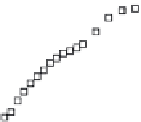Environmental Engineering Reference
In-Depth Information
1.2 Low Reynolds number problem
Most of the aerofoil sections for wind turbines have the common weakness induced
by the low Reynolds number problem, i.e. they have a critical Reynolds number
Re
c
around:
5
Re
=≈−×
Re
(1
2)
10
(1 )
c
If
Re
Re
c
, lift coeffi cients drop considerably. An example is shown in Fig. 2
for a MEL18M31 aerofoil section. Lift and drag coeffi cients are shown for four
Reynolds numbers,
Re
= 1
≤
10
5
, 2
10
5
, 5
10
5
, and 1
10
6
.
In the small attack
×
×
×
×
10
5
is quite different from
angle region of
a <
25°, the lift coeffi cient for
Re
= 1
×
10
5
.
The similar characteristics are found
and much smaller than those for
Re
≥
2
×
with various aerofoil sections.
What will happen with such a SWT that is often affected by low Reynolds number
problem? It would not start to rotate even if the wind speed becomes suffi ciently
higher than cut-in wind speed, because of absence of pitch control mechanism and
2.5
2
1.5
1
0.5
0
-100
-80
-60
-40
-
20
0
20
40
60
80
100
-0
.5
CL(Re=1E5)
CD(Re=1E5)
CL(Re=2E5)
CD(Re=2E5)
-1
CL(Re=5E5)
CD(Re=5E5)
CL(Re=1E6)
CD(Re=1E6)
-1.5
Attack Angle (deg)
0.2
0.15
0.1
0.05
0
0.05
-
0.1
-
MEL18M31
0.15
-
0.2
-
0
0.1
0.2
0.3
0.4
0.5
0.6
0.7
0.8
0.9
1
x/c
Figure 2: A sample of low Reynolds number effect (lift coeffi cient for various
Reynolds number of two-dimensional MEL aerofoil section).




















































































































































































































































































































































































Search WWH ::

Custom Search